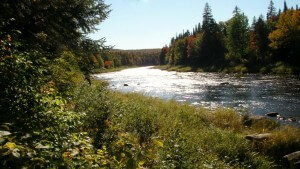
There has been much written on New Brunswick’s surface water. We should protect it. We should sell it. We should use it for fracking, tourism, or just simply leave it be for its own sake.
Everyone has an opinion. One thing, though—people in general do not have a handle on the state of our province’s water. Is it clean, cold and supporting fish? Is it degraded and needing help? Some say you cannot manage what you cannot measure. When it comes to water there is some logic to this maxim.
But wait, we did measure. When the Province passed laws and regulations in 2002 to study and protect surface waters it was ahead of the curve with its comprehensive water classification program. Nineteen watershed groups, volunteers with a love of the nature, rivers and streams in their communities embraced rigorous sampling and documented the (almost universally high) quality of these assets. They asked government to adopt their findings as baseline.
Why? Because the quality of our waterways is a direct reflection of how we manage the surrounding land. If we mismanage land, water quality deteriorates. Without baseline data, how can we tell if particular land use will help or harm a river or stream? That is what classification is all about: assigning a ‘class’ or quality to each stream, and then striving—through cooperative community oversight– to maintain that quality over time.
Today, fourteen years after the law and regulation were passed, there is still no official program to classify surface waters in New Brunswick. In 2014 the Ombudsman chastised government for wasting people’s (volunteer watershed groups’) time and effort. A total of five Ministers of Environment over close to thirty years have now waffled and sputtered about the program without implementing a single classification order, a critical step in the process.
Last summer, under a Right to Information request the Department released a legal brief claiming the water classification laws were vague, unenforceable and unlawful. [One wonders how many Justice Department lawyers had to have been asleep while drafting the instruments the Legislature approved.] Having this in hand enabled us to examine the government’s reasons for stalling on water classification—reasons even the Ombudsman hadn’t been able to extract during his 2014 study.
The newly-formed Friends of Water Classification and allied groups immediately sought another legal viewpoint. A leading environmental lawyer, experienced in classification in both Canada and the United States, studiously dismantled each of the government’s arguments. The Minister has the power, her opinion said. The Minister has the authority. The program is not ‘unlawful.’ The program could benefit from some additional guidelines, but the backbone of an effective water protection system is already there waiting, no, begging, to be put into motion.
In short, it made clear that NB could immediately, and legally, begin to work with community groups who have classified their watersheds as well as those who have not, yet are poised to be water stewards in partnership with the Province.
Since 2002 when the program was initiated, things have changed. The need to act is more urgent as NB faces severe threats from accelerating climate change. Flood damage at the mouths of coastal watersheds paired with property destruction such as occurred in the upper Saint John River and in Charlotte County in recent years will be more commonplace in future.
We need to act now to deploy water classification, a necessary planning and prevention tool, and to nurture the multi-stakeholder watershed groups who will do it in the volunteer service, and best interests, of their communities.
This guest commentary is by Margo Sheppard and Bill Ayer, members of the newly formed Friends of Water Classification.

